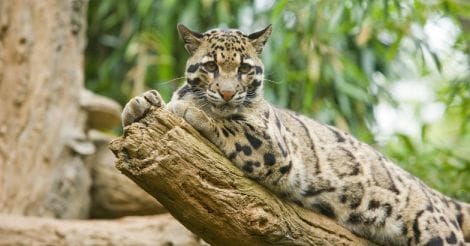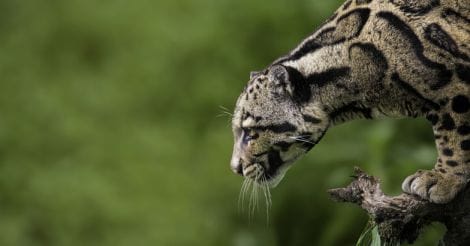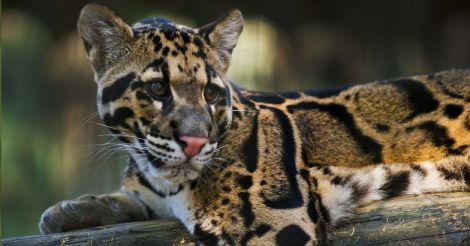Clouded leopards are a medium sized cat species that inhabit a significant large habitat, ranging from the Himalayan foothills across parts of South China extending into South East Asia. They have been reported from Nepal, Bhutan, China, India, Myanmar, Thailand, Malaysia and Indonesia.
This majestic cat species with distinctive coat color, resembling foliage in cloud covered mountainous or foothill habitats, suitable for effective camouflage has been reported to survive in both tropical and subtropical rainforests and different temperate forest types such as broad leaf, mixed and evergreen coniferous forests.
Currently, two distinct species are widely reported 1. Clouded leopard (Neofelis nebulosa) found in Nepal, Bhutan, India, China, Myanmar, Thailand and peninsular Malaysia; and 2. Sunda clouded leopard (Neofelis diardi), which is restricted to the Indonesian islands of Sumatra and Borneo.
 Photo: Rahul Ray
Photo: Rahul RayThe clouded leopard (Neofelis nebulosa) is reported to have three separate sub-species, of which only two are extant now; one being distributed across Nepal, Bhutan and India, and the other stretching from South China, Myanmar into South East Asia. The third sub species, Formosan clouded leopard, which is now considered to be extinct, was earlier reported from Taiwan.
In India, the species is restricted to Darjeeling Himalayas (West Bengal), Sikkim Himalayas (Sikkim) and North East India, which includes Assam, Meghalaya, Arunachal Pradesh, Nagaland, Manipur, Mizoram and Tripura.
The various sub species across Indian subcontinent, China and South East Asia may have overlapping ranges. However, very little authentic field data is currently available. Both clouded and Sunda clouded leopards have been designated as vulnerable by IUCN. Less than 10,000 (or may be even lesser!) of these leopards are currently reported by international conservation agencies.
 Photo: Getty Images
Photo: Getty ImagesClouded leopards are predominantly nocturnal and superbly adapted for arboreal life. They are one of the master climbers of trees among various large, medium sized and small cat species distributed across the continent of Asia. The mammal is superbly adapted to their ecosystems and wild, natural habitats and is extremely shy to be easily located during any time of the day.
The males and females look similar in coat patterns, but the females are slightly smaller in size compared to that of the males. This majestic cat species are also known to be highly territorial in nature and are not known to purr like other cat species. Cornered and isolated clouded leopards are often found to be be quite aggressive and attack people, if seriously provoked.
The survival of the species has been drastically impacted over past five decades due to a number of anthropogenic factors across its massive range, comprising parts of Nepal, Bhutan, China, India, Myanmar, Thailand, Malaysia and Indonesia. The common factors could be summarized as the following:
 Photo: Rahul Ray
Photo: Rahul Ray1. Loss and degradation of natural wild habitats and natural ecosystems due to illegal anthropogenic encroachments.
2. Rapid habitat fragmentation and habitat modification due expansion of to agriculture and industry into forested areas, together with infrastructural developments.
3. Indiscriminate poaching for skin, pelt, fur, teeth, claws, bones, body parts and for trophy collection.
4. Illegal wildlife trade operating across porous international borders with little or no monitoring at vulnerable points.
5. Natural and anthropogenic forest fires destroying premier clouded leopard habitats.
6. Degradation of suitable prey species due to over exploitation of forest habitats by adjacent remote, resident rural and tribal communities dependent heavily on local forest resources.
7. Unfortunate accidents in the highways and railway corridors criss-crossing across different clouded leopard ranges.
8. Lack of appropriate conservation efforts by several countries with clouded leopard habitats.
9. Over grazing and related anthropogenic activities (illegal timber, leaf, flower, fodder, medicinal plants and mushroom harvest) in forested areas with clouded leopard habitats has degraded their habitat qualitysignificantly resulting in acute habitat shrinkage.
 Photo: Getty Images
Photo: Getty Images10. Increasing human footfall in clouded leopard habitats disturbing the hunting, breeding as well as territorial integrity of the unfortunate predator cat.
Like the red pandas, clouded leopards too need some sincere conservation efforts. Some captive breeding programs for clouded leopards are already practiced across their distribution range countries, Europe and the US zoos. However, more such large-scale captive breeding programs need to be internationally coordinated and integrated for more effective conservation efforts. Unless strong steps are taken to curb over-grazing and exploitation of natural habitats and poaching and illegal wildlife trade are seriously regulated, the majestic cat species will be at substantial risk of population decline.
(The author is a Canada and India based freelance journalist specializing in global geo-political, strategic and foreign policy issues, science & technology and environment & conservation related themes.)
More from Call of the Wild

























 Photo: Getty Images
Photo: Getty Images